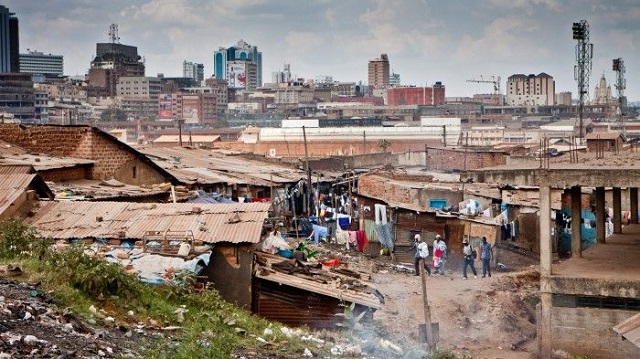
Kampala, Uganda | THE INDEPENDENT | Forty five-year-old Sarah Nsangi, is a resident of Katanga Kimwanyi zone in Wandegeya market in Kawempe division in Kampala metropolitan area. She has been part of tens of hundreds of residents of this area now counting over 30 years.
Nsangi also runs a shop with a colleague who is a tailor while she makes books. When URN visited her, Nsangi was rushing out fearing that the rain could start before she could reach home.
Her biggest fear though was safety for she said electricity supply had been cut off due to illegal connections and thieves were using the opportunity to break into houses and snatch resident’s property.
Kimwanyi is one of the Kampala slums. According to UN-HABITAT, a slum household is a group of individuals living under the same roof in an urban area who lack durable housing of a permanent nature that protects against extreme climate conditions and sufficient living space which means not more than three people sharing the same room.
Others include lack of access to safe water in sufficient amounts at an affordable price, adequate sanitation in the form of a private or public toilet shared by a reasonable number of people and security of tenure that prevents forced evictions.
Going by this standard, several areas in Bwaise, Namuwongo, Kisenyi, Kifumbira Kamwokya and Katanga in Kampala constitute a slum. Apart from insecurity, the housing in slum areas is poor. The houses are congested and sub-standard.
One has to squeeze through corridors to find their way through while strangers can easily lose their way. Nsangi says the small houses are cheap and affordable for low income earners. Depending on the size and quality of house and the landlord, one can acquire a house from as low as Shillings 30.000 a month.
These houses usually lack utility supplies like water and electricity. Some don’t have toilets or latrines contrary to the Public Health Act of 1935 that requires that every new building have a provision for latrines before local authorities approve a plan for its construction.
Nsanji wishes that government works out a plan to develop the slum to improve the standards of living of slum dwellers. She has no plans to leave the area citing its proximity to the city center, which eases access to facilities in the city.
Emmanuel Ahimbisibwe, the Katanga Kimwanyi zone secretary is concerned that the residents are exposed to diseases due to the poor sanitation. The poor access of the area also worries Ahimbisibwe. He however, blames the development of slums on poor planning by government.
Ahimbisibwe says government through Kampala Capital City Authority-KCCA as an urban authority watch while buildings emerge in contravention of physical planning guidelines.
The State Minister for Housing, Isaac Musumba says government has plans of developing slums but still faces challenges of multiple interests on land.
“In these areas, you find the owner of the land, owner of the structure and tenant as different people,” he said. Musumba says this possess a challenge to government as they would need to engage all stakeholders something that slows the efforts.
He however says government has started an initiative in Katwe and is engaging with stakeholders to see how they can develop the slums.
Sam Mukasa-Kintu a retired Urban Planner, says government needs to draft a comprehensive plan to acquire land in slums and developed them. He says with proper planning government can find resources from donors to compensate residents and landlords in slums such that they can developed them.
Amanda Ngabirano, an Urban Planner and lecturer at Makerere University also says government needs a comprehensive urban plan to deal with slums. She says government needs to dictate land use and implement guidelines on urban development.
Ngabirano says government should establish affordable housing for slum dwellers. This she says is achievable if government draws a clear long term plan and influences people to appreciate shared housing rather than live in single ownership houses that are in a sorry state.
Government has attempted to establish what it referred to as low cost housing. National Housing and Construction Company-NHCC has set up hundreds of housing units in Kampala for instance the Namungoona Housing estate.
Government has also worked with private companies like Admas Construction Company that constructed housing units along Lake Drive in Luzira. The project has however have been criticized for not serving its goal.
The Namungoona units were priced at Shillings 300 million while those in Luzira cost Shillings 630 million, which is way above the reach of slum dwellers.
Vincent Agaba, a real estate agent, says that while provision of cheap and affordable housing is one of the measures to eradicate slums, there is need to address factors that influence the prices of houses.
For instance, he says government should work with private companies willing to invest long term in housing and slum development projects. The investment could involve setting up houses that people would pay for progressively over a longer period of time.
Agaba adds that financial institutions should be persuaded into providing cheap mortgages such that low income earners can also invest in housing.
According to the Uganda National Housing policy 2016, the overall housing situation in the country is characterized by inadequate housing in terms of quality and quantity both in rural and urban areas with a housing deficit of about 1.6 million housing units, out of which 210,000 units are needed in the urban areas. An estimated 900,000 housing units are sub-standard and need replacement or upgrading.
Uganda is one of Africa’s most rapidly urbanizing countries, with a population base estimated at about 43 million, a high population growth rate of 3.2% and a high rate of urban growth estimated at over 5% per annum. Over 20 million of Uganda’s population live in urban areas. Growth in urban population has given birth to a number of slums.
******
URN
 The Independent Uganda: You get the Truth we Pay the Price
The Independent Uganda: You get the Truth we Pay the Price


